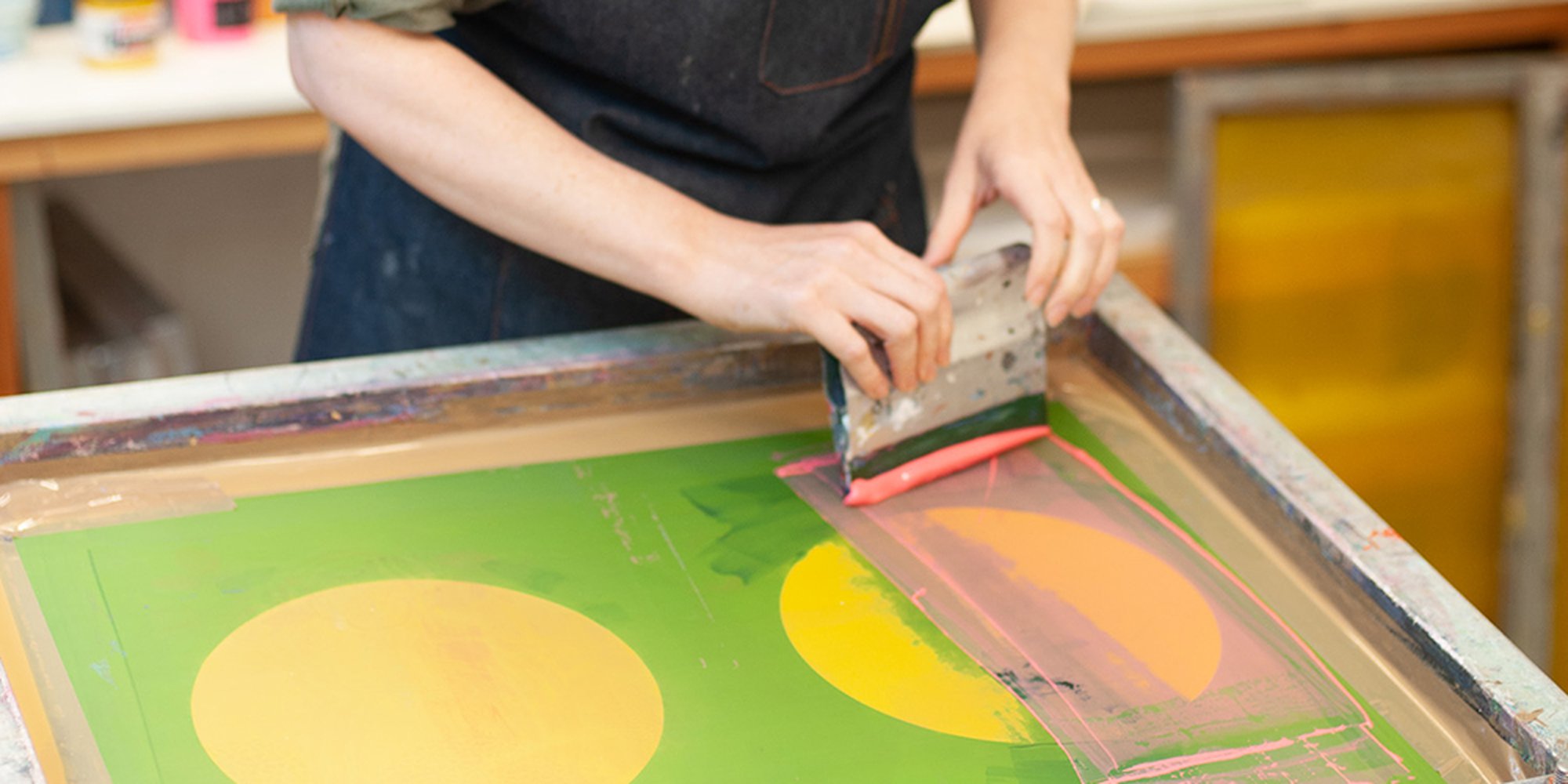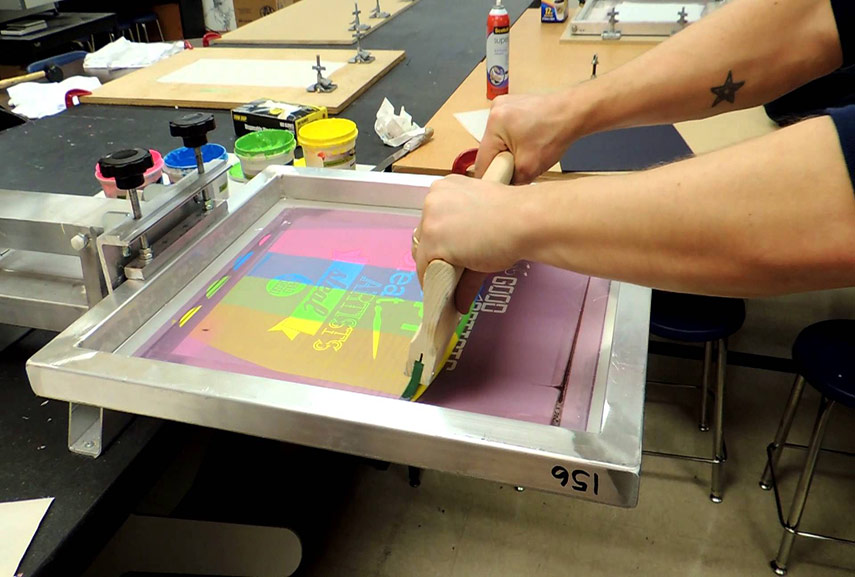ChatGPT said: Top reasons to work with 10:9 Design Texas for promotional products
Discover the Different Types of Screen Printing Techniques for Your Following Project
Screen printing uses a diverse variety of strategies that can improve any kind of creative job. From traditional methods like serigraphy to modern-day developments such as direct-to-garment printing, each technique has its unique advantages. Specialized options, including environment-friendly and metallic inks, present also more possibilities. Recognizing these strategies can considerably influence the final result. Nonetheless, the difficulty hinges on choosing one of the most ideal method for specific demands and desired results. What elements should one take into consideration?

The Fundamentals of Screen Printing
Screen printing might seem complex, it is essentially an uncomplicated procedure that includes transferring ink through a mesh screen onto various surfaces. The method starts with the development of a stencil, which specifies the style to be printed. This pattern is connected to a mesh screen, generally constructed from polyester or nylon. As soon as the stencil remains in location, ink is related to the screen and pushed through the mesh making use of a squeegee, causing the preferred pattern being printed on the underlying product.
Screen printing can be executed on a wide variety of substrates, consisting of paper, textile, and plastic, making it a versatile option for different projects. The procedure permits vivid colors and complex styles, making it popular in sectors such as advertising, style, and art. Comprehending these essentials gears up people with the fundamental expertise called for to explore even more innovative techniques in screen printing.
Typical Screen Printing Techniques
Traditional screen printing methods have actually been employed for centuries, protecting the workmanship and creativity of this method. This approach uses a mesh screen to transfer ink onto a substratum, such as fabric or paper, enabling resilient and vivid layouts. The process begins with producing a pattern, which obstructs certain areas of the screen to regulate where the ink will be applied.
One prominent strategy is serigraphy, often used for minimal editions and imaginative prints. An additional is making use of water-based inks, which are eco-friendly and give a soft feeling on fabrics - 10:9 Design Screen Printing. In addition, standard techniques can include hands-on printing, where artisans apply ink with a squeegee, ensuring accuracy and interest to detail
These strategies stay valued in the market for their responsive top quality and the special structures they create, appealing to both makers and customers who appreciate the heritage of screen printing.
Digital Screen Printing Innovations
As the demand for faster manufacturing and personalization in the printing industry has actually surged, electronic screen printing innovations have actually emerged as a game-changer. This modern technology blends traditional screen printing techniques with digital procedures, enabling rapid prototyping and intricate styles that were previously tough to achieve. One substantial improvement is the introduction of direct-to-garment (DTG) printing, which promotes high-grade, full-color prints on different fabrics without the need for displays. Additionally, innovations in ink formulations have actually led to green choices that maintain lively shades while reducing ecological influence. Using automated systems further enhances manufacturing, decreasing labor expenses and boosting precision. These technologies not only deal with little set orders and personalized layouts but also enable quicker turn-around times, making them ideal for services focused on meeting customer demands in a hectic market. Digital screen printing, subsequently, stands for a vital advancement in the domain name of printing strategies.
Specialty Screen Printing Methods
Discovering specialty screen printing techniques discloses a diverse array of methods that push the borders of creative thinking and functionality in the printing industry. Among these, glow-in-the-dark inks offer an one-of-a-kind aesthetic result, making layouts come active in low-light conditions. Metallic inks, known for their shimmering finish, add a touch of high-end to published materials. Another innovative method is discharge printing, which removes color from the textile rather than including ink, leading to a soft, vintage feel. High-density printing produces an increased structure on the surface, enhancing responsive involvement. Additionally, water-based inks are acquiring popularity for their vibrant shades and minimized environmental effect. Each of these specialty techniques deals with certain style requirements, allowing artists and brand names to create standout products that resonate with their target markets. By leveraging these approaches, services can elevate their screen printing tasks to new heights, ensuring remarkable impressions.
Eco-Friendly Screen Printing Options
Green screen printing alternatives are getting traction as the sector moves in the direction of sustainability. Lasting ink choices and using naturally degradable materials are crucial parts in reducing the ecological impact see this website of the printing procedure. By adopting these techniques, screen printers can add to a more lasting future while preserving top quality outcomes.
Sustainable Ink Options

Biodegradable Products Usage
As the screen printing sector progresses, the incorporation of eco-friendly materials is coming to be significantly essential for eco mindful techniques. Designers and manufacturers are currently exploring inks and substratums made from natural, renewable energies that disintegrate much more effectively than typical equivalents. These naturally degradable options minimize plastic waste and lessen environmental influence, aligning with the expanding demand for Check Out Your URL sustainable items.
Common examples consist of water-based inks and organic cotton textiles, both of which reduce harmful chemicals and promote eco-friendliness. Brand names that take on these materials often improve their market charm, bring in customers who focus on sustainability. As awareness of environmental problems remains to climb, the shift towards biodegradable products in screen printing is likely to acquire energy, cultivating a greener sector standard.
Selecting the Right Method for Your Task
Just how can one determine the most appropriate screen printing strategy for a specific project? The choice hinges on numerous aspects, including the material to be printed on, the complexity of the style, and the preferred production volume - 10:9 Design Abilene. For example, direct-to-garment printing is optimal for complex styles with countless colors, while conventional screen printing succeeds for bigger runs of easier graphics
Furthermore, consideration of the end-use of the printed thing is essential. For exterior applications, methods that supply sturdiness and climate resistance, such as plastisol ink, might be preferred. Alternatively, environmentally-conscious projects may profit from water-based inks or biodegradable products.
Ultimately, recognizing the project's one-of-a-kind demands allows for an enlightened option, making sure both aesthetic allure and click this practical longevity. By examining design intricacy, material compatibility, and manufacturing scale, one can effectively pick the most proper screen printing method to meet their job's objectives.
Often Asked Questions
What Is the History of Screen Printing?
Screen printing came from ancient China around 1000 ADVERTISEMENT, evolving with Japan and Europe. By the 20th century, it became prominent in industrial art and style, transforming just how designs were generated and distributed around the world.

Just how Do I Prepare Art Work for Screen Printing?
To prepare art work for screen printing, one must guarantee high resolution, use a suitable shade setting, develop different layers for every color, and convert message to details, assuring compatibility with the printing procedure and desired end result.
What Products Are Finest for Screen Printing?
The most effective products for screen printing include high-quality inks, durable screens, and ideal substratums like cotton, polyester, or blends. Additionally, making use of ideal emulsion and mops can boost the printing process and final outcomes.
Can I Evaluate Print at Home?
Yes, screen printing at home is feasible. With the ideal materials, setup, and strategies, individuals can develop high-grade prints. Careful consideration of work area and tools is crucial for successful results.
What Are Common Errors in Screen Printing?
Usual blunders in screen printing consist of improper exposure times, insufficient ink consistency, imbalance of screens, insufficient cleaning of materials, and ignoring to check prints. These mistakes can endanger the top quality and precision of the last item.
Screen printing might appear facility, it is fundamentally a straightforward process that involves transferring ink through a mesh screen onto various surfaces. As the demand for faster production and personalization in the printing market has surged, digital screen printing innovations have actually emerged as a game-changer. Discovering specialized screen printing approaches exposes a diverse array of strategies that push the borders of creative thinking and performance in the printing industry. The ideal products for screen printing include top notch inks, sturdy displays, and appropriate substratums like cotton, polyester, or blends (10:9 Design contact). Usual errors in screen printing include inappropriate direct exposure times, insufficient ink consistency, misalignment of displays, inadequate cleaning of products, and ignoring to evaluate prints